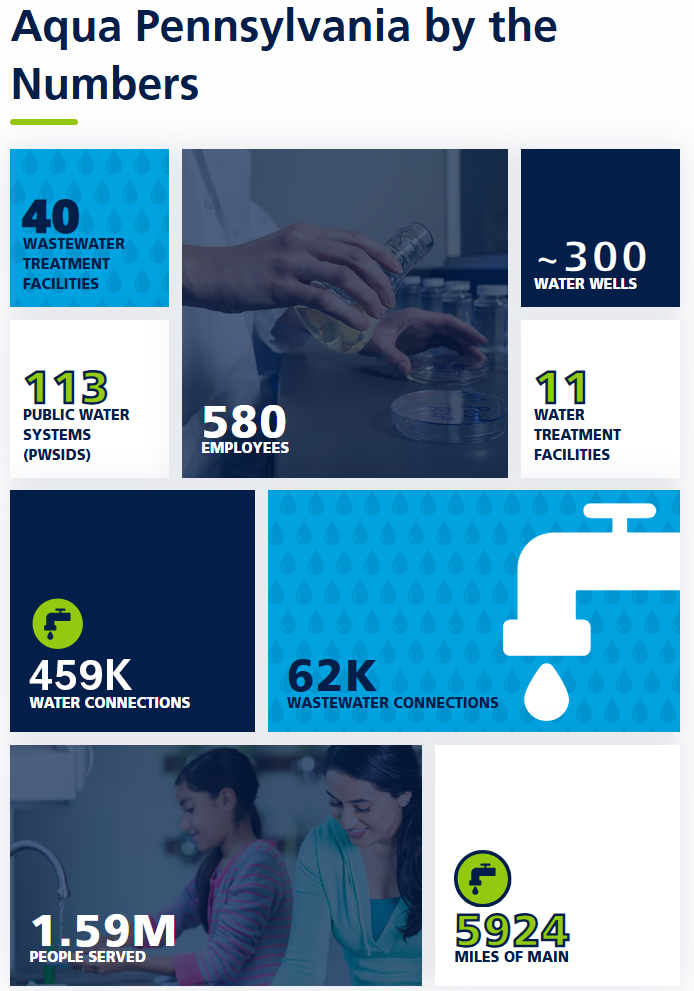Aqua Pennsylvania

Aqua Pennsylvania Leadership
Marc Lucca, President
Keeping Pennsylvania Strong
In 1886, a group of Swarthmore College professors received a charter to supply water to the residents of Springfield Township, Delaware County. Since then, Aqua Pennsylvania has been continuously growing, and now supplies water to approximately 1.5 million people across the Keystone state.
At Aqua Pennsylvania, water quality and continuous service are our highest priorities. We strive every day to listen to our customers and invest in the safest, most up-to-date technology and infrastructure improvements and enhancements that benefit our customers and their daily lives.
It’s our commitment for a better Pennsylvania: by employing the best licensed treatment operators, scientists, engineers and experts, we’re able to surpass federal regulations, increase operational effectiveness and invest in your infrastructure.
PA Service Areas & Water Sources
Honesdale/White Haven Division Service Area
Parts of Carbon County, Lackawanna County, Lehigh County, Luzerne County, Monroe County, Northampton County, Pike County, Schuylkill County, Susquehanna County, Wayne County and Wyoming County.
Roaring Creek/Susquehanna Division Service Area
Parts of Adams County, Bradford County, Columbia County, Cumberland County, Juniata County, Northumberland County, Schuylkill County and Snyder County.
Shenango Division Service Area
Parts of Clarion County, Clearfield County, Crawford County, Forest County, Lawrence County, Mckean County, Mercer County, Venango County, and Warren County.
Southeastern Division Services Area
Parts of Berks County, Bucks County, Chester County, Delaware County and Montgomery County.
Water Sources
Aqua Pennsylvania sources its water from surface water from the Crum, Pickering, Brandywine, Perkiomen, Neshaminy, Ridley and Chester creeks, Schuylkill and Delaware rivers, the Upper Merion Quarry and the Shenango River in western Pennsylvania, and groundwater from more than 100 deep wells provide water for Aqua Pennsylvania.
Aqua Pennsylvania Documentation
Regulatory Agencies
Aqua PA Water and Wastewater Rates
More on your rates and tariffs available here.
Pennsylvania Water Quality & Safety
Learn more about the water quality and safety challenges that affect Pennsylvanians the most.
Chloramines
Chloramines are a commonly used disinfectant in drinking water. They're used in many water systems across the U.S., including some of Aqua Pennsylvania’s systems. Chloramines have been used for more than 90 years and are completely safe. Learn more about our use of chloramines.
Discover Use of ChloraminesChromium
Chromium is a naturally occurring element and can be found in untreated water. All of Aqua's water is within the EPA's limits for this contaminant. Learn more about what chromium is and what Aqua is doing to reduce this metal in water.
Understand Chromium ContaminationLead Water Lines
Lead is a naturally occurring metal that can cause a variety of adverse health effects. Lead exposure through drinking water is primarily a result of the corrosion of lead pipes and plumbing materials. The Pennsylvania General Assembly determined it is in the public interest for water utilities to assist customers in the replacement of customer-owned lead service lines throughout Pennsylvania. Under the Customer Lead Service Line Replacement Program, Aqua will replace both the company and the customer-owned portion of the service line at no direct cost to the customer.
More on the Aqua PA Lead Service Line Replacement Program, as well as details on community meetings, can be found within the Lead Service Line Replacement section of the Lead page. Please click the link below to learn more.
Learn MorePFAS
Two contaminants — Perfluorooctanoic acid (PFOA) and Perfluorooctanesulfonic acid (PFOS), known as a part of the PFAS family of chemicals — have been found in drinking water supplies across the country and around the world.
In May 2016, the U.S. Environmental Protection Agency replaced its 2009 provisional health advisories for PFAS with new, lifetime health advisories, setting a health advisory level of 70-parts per trillion (PPT) for both contaminants. This lower limit is of particular interest in those areas of eastern Montgomery County and Bucks County, where groundwater contamination from PFAS is believed to originate from nearby military bases.
Since the health advisory limit was announced in 2016, Aqua has taken proactive measures to ensure that water provided outperforms the EPA’s 70 PPT health advisory, including investing heavily in equipment for regular in-house analysis; installing granular activated carbon (GAC) filters on two systems with the highest level of PFAS; conducting engineering evaluations of the Neshaminy water treatment plant and evaluating impacts of the Air National Guard’s treatment system on levels in the creek; and continually assessing alternative treatment options, including ion exchange resins and other technologies.
Learn more about what we're doing in Pennsylvania to mitigate risk from PFAS below.
PA Infrastructure Investments
